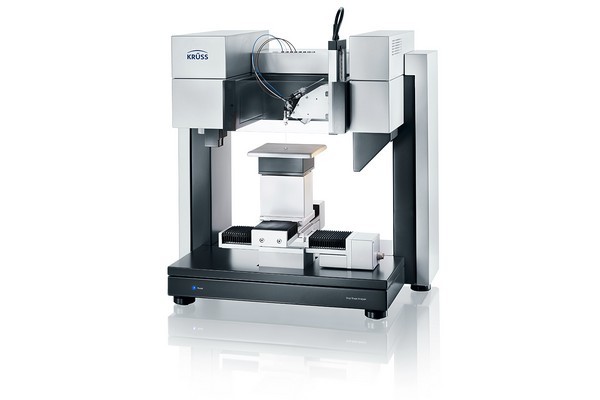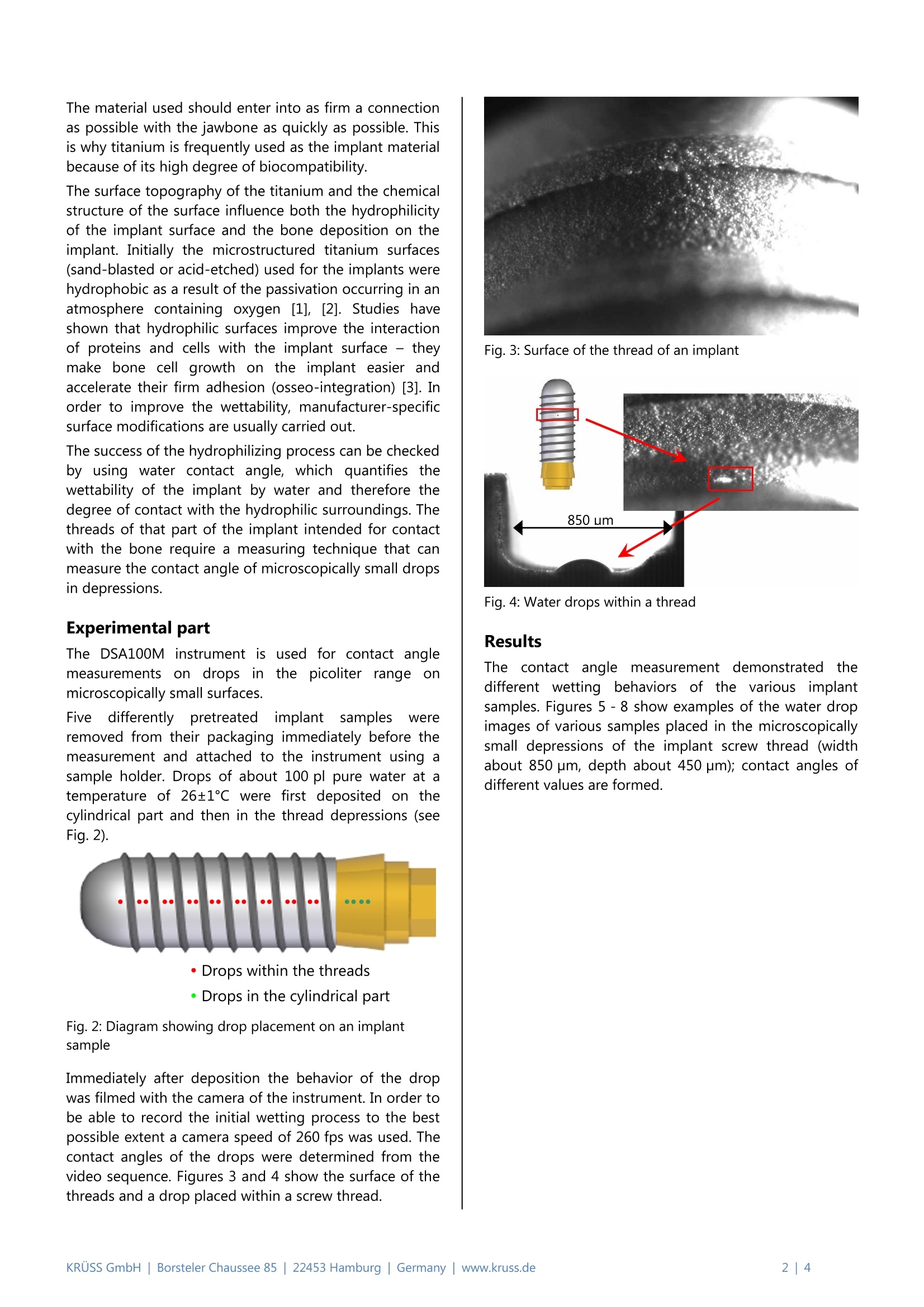
方案详情
文
植入牙润湿性决定生理环境的接触程度和其他因素一起成为生物相容性测试方法。钛种植牙润湿行为涉及到水接触角研究。最大的挑战在于在螺旋线定位小液滴测量接触角。这时可使用DSA100M光学接触角测量接触角。
方案详情

Application Report Characterization of microscopically small surfaces on dental implants byusing contact angle measurements on picoliter drops Abstract With tooth implants the wettability determines the degree of contact with the physiological surroundings and cantherefore -together with other influencing factors - be a measure of the biocompatibility of the implant material. In thearticle presented here the wetting behavior of titanium dental implants with respect to water was studied by measuringthe contact angle with water. The particular challenge in this task lay in positioning small drops in the implant screwthread and measuring their contact angles. Such measurements are possible with the DSA100M optical contact anglemeasuring system, which can dose out very small drops down to a few picoliters exactly and then analyze them -even indepressions. Background Dental implants used today are normally rotationallysymmetrical pegs provided with a screw thread; these arescrewed directly into the jawbone (see Fig.1). Fig.1:Inserting a dental implant The material used should enter into as firm a connectionas possible with the jawbone as quickly as possible. Thisis why titanium is frequently used as the implant materialbecause of its high degree of biocompatibility. The surface topography of the titanium and the chemicalstructure of the surface influence both the hydrophilicityof the implant surface and the bone deposition on theimplant. Initially the microstructured titanium surfaces(sand-blasted or acid-etched) used for the implants werehydrophobic as a result of the passivation occurring in anatmosphere containing oxygen [1], [2]. Studies haveshown that hydrophilic surfaces improve the interactionof proteins and cells with the implant surface -theymake bone cell growth on the implant easier andaccelerate their firm adhesion (osseo-integration) [3]. Inorder to improve the wettability, manufacturer-specificsurface modifications are usually carried out. The success of the hydrophilizing process can be checkedby using water contact angle, which quantifies thewettability of the implant by water and therefore thedegree of contact with the hydrophilic surroundings. Thethreads of that part of the implant intended for contactwith the bone require a measuring technique that canmeasure the contact angle of microscopically small dropsin depressions. Experimental part The DSA100M instrument is used for contact anglemicroscopically small surfaces. Fivedifferentlypretreated implantsampleswereremoved from their packaging immediately before themeasurement and attached to the instrument using asample holder. Drops of about 100 pl pure water at atemperature of 26±1C were first deposited on thecylindrical part and then in the thread depressions (seeFig.2). Drops within the threads ·Drops in the cylindrical part Fig. 2: Diagram showing drop placement on an implantsample Immediately after deposition the behavior of the dropwas filmed with the camera of the instrument. In order tobe able to record the initial wetting process to the bestpossible extent a camera speed of 260 fps was used. Thecontact angles of the drops were determined from thevideo sequence. Figures 3 and 4 show the surface of thethreads and a drop placed within a screw thread. Fig. 3: Surface of the thread of an implant Fig. 4: Water drops within a thread Results The contact angle measurement demonstratedtthedifferent wettingbehaviors of the various implantsamples.Figures 5 -8 show examples of the water dropimages of various samples placed in the microscopicallysmall depressions of the implant screw thread (widthabout 850 um, depth about 450 um); contact angles ofdifferent values are formed. Fig. 5:Drop in thread depression of sample A Fig. 6: Drop in thread depression of sample B Fig. 7: Drop in thread depression of sample D Fig. 8: Drop in thread depression of sample E Table 1 contains the mean values of the contact anglesCAmean for the depressions and cylindrical areas for thefive samples identified by the letters A to E. Sample CAmean/ Depression CAmean/ Cylindricalarea A 116.5° 116.2° B 103.0° 103.7° c 99.5° 105.9° D 77.2° 84.5° E 19.3° 37.6° Tab.1: Contact angles (mean values) of water drops onimplant samples The limiting value for wettability is represented by acontact angle of 90°; water contact angles above 90°indicate a hydrophobic solid surface; from 90°down to0°the surfaces are increasingly hydrophilic. The limitingvalue of 90°was exceeded for three of the five samplesstudied; both on the cylindrical part and in the threaddepressions. In contrast, samples D and E exhibitincreasingly hydrophilic behavior. According to the Baiermodel [4], which was developed for contact with bloodand biomaterials, there isa relationship betweenbiocompatibility, bioadhesion and the contact angle.According to this, a hydrophilic surface with a contactangle from 0-30°exhibits very strong bioadhesion. Inaccordance with this model, the high hydrophilicity ofsample E means that it is to be expected that it will havethe highest degree of biocompatibility of all the analyzedsamples. ThedatainnTab.ialso indicatesthat at lowerwettabilities the results for the cylindrical part will agreewith those for the threads, whereas with hydrophilicsamples increasingly larger differences between thesetwo areas will occur. From this result it can be seen thatthe measurement of the easier-to-characterize cylindricalpart alone is not sufficient, but that the thread surfaceintended for intensive tissue contact must be studiedseparately. Summary Micro-drop measurements with suitable dosing, optics,camera techniques and drop shape analysis softwarepermitwettabilitystudies:S onnmicroscopically smallsurfaces and in depressions. With the contact anglemeasuring systemDSA100Mthe hydrophilicc andhydrophobic properties of the cylindrical part of dentalimplants can be determined. In addition, it has beenpossible to make measurements in the depressions ofthe threads of the implant that are to be screwed into thejawbone. In this way it was not only possible todetermine the wetting behavior of five implant samplesqualitatively (wetting3 Corrnon-wetting), but alsoquantitatively by using the measured contact angles. Inaccordancewith[4], suchmeasurementsprovidevaluable information about the expected biocompatibilityofthe material. ( [1 ] H.P. Boehm, " "Acidi c and basi i o c properties s 0 of hydroxylated metal oxide s u rfaces", D iscussions Faraday Society, 1971,52,264-275. ) ( [2] J. Martin, Z . Schwartz, T.W. Hummert, D.M. S c hraub, J. Simpson, J. L ankford: : "Effect off t t i itanium s urface roughness on pr o fileration, differentiation and protein synthesis of h uman ost e oblast-like ce l ls", J. Biomed. Mater. Res. 1995, 29, 389-401. ) ( [3] F. Schwarz, M. Herten, M. Wieland, M. Dard, J . B ecker: ,Chemically modified, ultra-hydrophilic titanium implantsurfaces", Oral and M axillofacial Surgery, 2007, 1 1,11-17. ) ( [4] Baier, "The role of surface energy in t hrombogenesis", Bull. N.Y. Acad. Med.1972,48, 257-272. ) KRUSS GmbH |IBorsteler Chaussee Hamburg|Germany |www.kruss.de|
确定




还剩2页未读,是否继续阅读?
克吕士科学仪器(上海)有限公司为您提供《种植牙中接触角检测方案(接触角测量仪)》,该方案主要用于牙齿中接触角检测,参考标准--,《种植牙中接触角检测方案(接触角测量仪)》用到的仪器有KRUSS DSA100接触角测量仪
相关方案
更多









